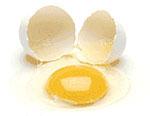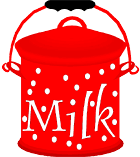Years ago, when I went out to my new chicken house and found the very first freshly laid egg, I stared at it in awe. “How did that hen do that?” I wondered. She takes in grain and bugs and kitchen scraps and turns them into an egg. Shell on the outside, white and yolk on the inside, all proper and perfect. Under the right conditions (or hen) that egg could even become a chick. Just amazing!

I still think every egg is a miracle, though they appear on our farm by the dozen every day. Our leading-edge chemists are miles from being able to convert cracked corn and cabbage leaves into an egg, much less a chick. The biotech biz can’t make grass into wool and lambs either, though my sheep, which were not at all smart, used to do it with great reliability.
All these years the one farm miracle I never got to witness firsthand was the transformation of hay into calves and milk. I never got a cow. I was daunted by their size and by the prospect of never-fail, twice-daily milkings. “The only difference between being in jail and having a cow,” my then-husband used to recite, “is that in jail you don’t have to milk the cow.”
So I stuck with chickens and sheep, until two years ago, when one of my farm-mates drove in one day with a tiny Jersey calf in the back of the truck. We named her Maple. Maple has just had her own first calf, and we are awash in milk.
I shouldn’t have been surprised at how good fresh, sweet, organic milk is. After all, once I tasted fresh organic eggs I never went back to supermarket ones. The same goes for vegetables and fruits out of the garden. But somehow I thought milk was milk was milk. So I have just learned one more time what we give up in taste and quality for the dubious privilege of living far away from the sources of our increasingly industrialized food.
I was also surprised at the quantity. Jerseys are not big producers, and ours is still working up to her peak, but she’s already milking five gallons a day. That’s nothing to a big farm with Holsteins and vacuum lines and bulk tanks. But when you’re operating out of your kitchen, five gallons a day is a river — a river of possibilities. You can do so many great things with milk!

Most of ours goes into cheese. Up to a month ago I had only the vaguest idea how milk becomes cheese, though this age-old art was once practiced in most rural households. Here’s how it works. You heat milk gently in a stainless steel vat and stir in a magical lactobacillus that turns the milk sugar lactose into lactic acid. You monitor the acidity of the mix to follow the bugs’ working. At just the right moment you add rennet, which congeals the curds. Then, depending on what kind of cheese you’re making, you cut, heat, stir, and salt the curds, scoop them into cheesecloth-lined forms, and press them (with bricks or a bucket of water). The next morning you have a wheel of cheese. You soak it in brine, then age it, ideally in a cave with constant temperature and humidity. Lacking a cave, we built a walk-in cooler.
We just tasted our first cheese, now 45 days old. It’s bland, because it’s only halfway through its minimal aging period. But it’s nutty, elastic, melty, good cheese. In my totally biased opinion, it’s on its way to glory. As with that first egg, I’m in awe.
I am not good at delayed gratification, so I take some milk to experiment with products that can be eaten immediately. So far my favorite trick is this: I start with two gallons of milk and scoop off the top layer of wonderful, thick cream. The cream goes into a hand-cranked churn. After 20 minutes of lackadaisical cranking (I read a book while I do it), the paddles hang up on a half pound of golden butter. I pour off three cups of surrounding liquid, which, kids, is called buttermilk. Great for biscuits or pancakes.
Taking off the cream leaves a gallon and a half of skim milk. That I warm to 90 degrees and stir in a little commercial buttermilk (which contains live lactobacillus). After sitting overnight, it separates into white jelly-like curds and watery yellow whey. (Along came a spider and sat down beside her … now I know where those nursery rhymes come from.) I cut the curds into pieces, warm them a little, scoop them out, add a bit of salt, and voila! A quart and a half of low-fat cottage cheese! I feel very clever, though it was the bacillus and the cow and the housemate who milked the cow who did the real work.
One more transformation could turn the whey into ricotta. But we make that with the whey from the other cheesemaking, so our refrigerator is well stocked. (Lasagna, blintzes, cheesecake!) I take the whey out to the chickens, who slurp it up contentedly. It’s full of nutrients that flow into the eggs. The composted chicken and cow manure go to the garden to flow into the vegetables.
Simple miracles. Satisfying work, like baking bread or building a shelf. Fresh, delicious food. Nutrient cycles closed right at hand. Health for land and people. Sometimes I wonder, with all our supposed progress, what we’re rushing toward and what we’re leaving behind.

